Introduction
A nonnative species is defined as a species introduced either intentionally or accidentally outside of its natural geographic distribution. An invasive species or invader is a nonnative species that causes (or is likely to cause) economic or environmental harm or harm to human health. In the next 50 years, an estimated one million species are in danger of going extinct globally. Invasive species are one of the major drivers of this decline in biodiversity (Diaz et al. 2019). As globalization, international trade, and tourism rise, so does the frequency of intentional and accidental introduction of nonnative species. This publication is written for the general public and describes why invasive species are an important issue in Florida and how nonnative species become invasive by moving through five stages of human-aided biological invasion [(1) transport, (2) introduction, (3) establishment, (4) spread, and (5) negative impacts (Blackburn et al. 2011)]. The article also connects these stages to examples in Florida.
Why Florida?
Florida’s tropical/subtropical climate and peninsular geography make it extremely vulnerable to biological invasions. Our climate overlaps with some of the most biodiverse regions in the world, and species from these regions are predisposed to tolerate our climatic conditions. Additionally, Florida has over 35 international ports of entry (Florida Ports Council 2021; FDOT 2021), and receives approximately $80 billion of cargo (US Census Bureau 2021) as well as nearly 120 million tourist visits annually (VISIT FLORIDA Research 2021). This increases the frequency of accidental and intentional transport of nonnative species to our state. However, even though many nonnative species are introduced to Florida every year, only a small percentage of those will experience the right conditions to become invasive (Williamson and Fitter 1996).
Florida has many unique ecosystems, including the Everglades “river of grass,” crystal clear freshwater springs, biologically diverse pine rocklands, imperiled dry prairie, and tropical hardwood hammocks, making it one of the most species-rich states in the country (Figure 1) (Rocus and Mazzotti 2017). Florida’s natural areas are crucial to preserving rare, threatened, or endangered species endemic to the state, including the Key deer (Odocoileus virginianus clavium), Everglade snail kite (Rostrhamus sociabilis plumbeus), Schaus’ swallowtail butterfly (Heraclides aristodemus), and pygmy fringetree (Chionanthus pygmaeus). Currently, more than half of Florida’s land area is either in development or used for agriculture, and the remaining natural areas are declining in quality due to current biological invasions, urban/suburban sprawl, and other associated effects (Volk et al. 2017). Finally, invasive species cost the state over $179 million annually in agricultural and forestry losses (Schmitz 2002), and the cost of managing invasive plants on Florida’s conservation lands alone is approximately $45 million per year (Hiatt et al. 2019). By identifying the invasion process, we can understand how biological invasions occur and help prevention and eradication efforts to preserve our state’s natural resources.
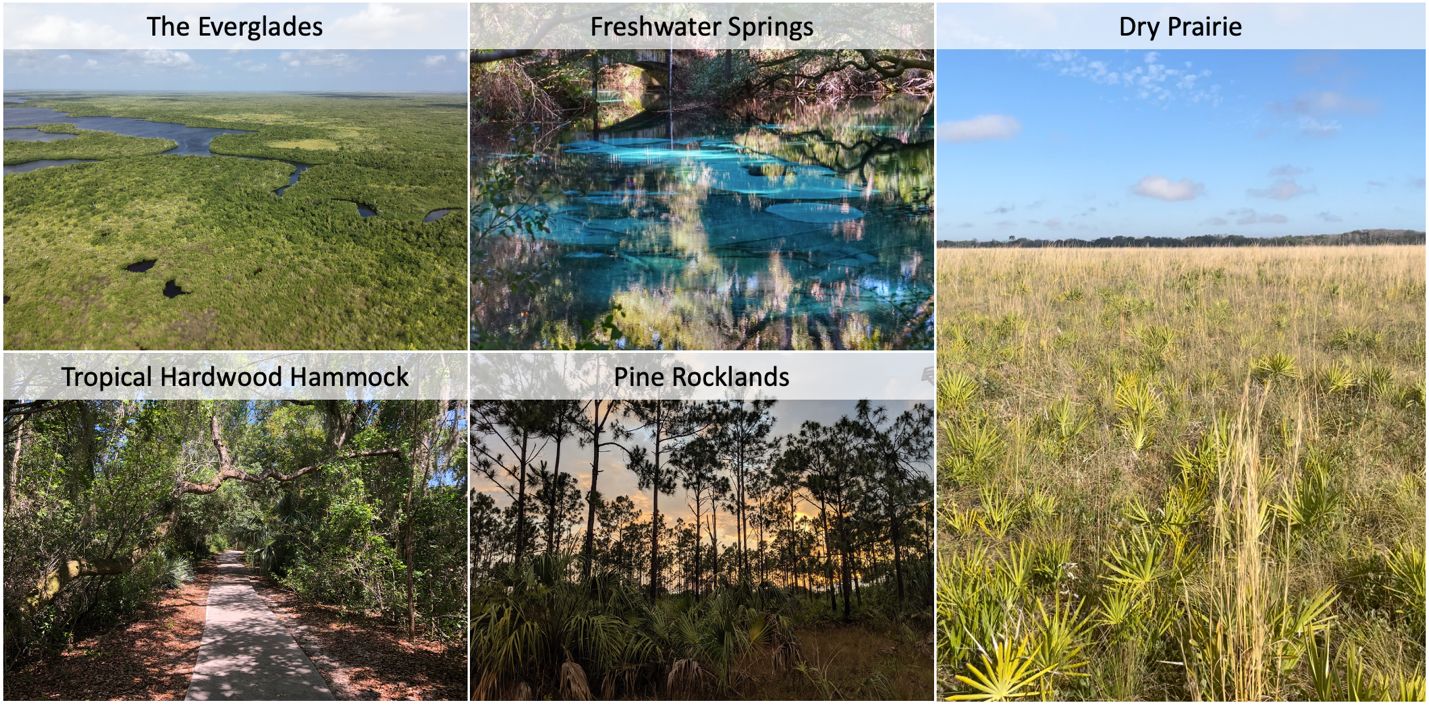
Credit: Top left—Drew Hiatt, UF/IFAS; Top center—Emily Bell, UF/IFAS; Top right—Brent Sellers, UF/IFAS; Bottom left—Jennifer Possley, Miami-Dade County Environmentally Endangered Lands (EEL); Bottom center—Lydia Cuni, Miami-Dade County EEL
This publication describes the process of how a nonnative species becomes an invader with examples from Florida. This framework was modified slightly and provides a simple model that can be applied to human-aided invasions of all taxa (plants, animals, microorganisms) (Blackburn et al. 2011). We have added “negative impacts” to the original framework, so it falls within widely accepted definitions of “invasive species” (Secretariat of the Convention on Biological Diversity 2001; U.S. Executive Order No. 13112 1999). In this model, there are five stages of biological invasions: (1) transport, (2) introduction, (3) establishment, (4) spread, and (5) negative impacts. Note that there are environmental (e.g., climate and soil type) or biological (e.g., presence of predators and reproduction success) barriers that may halt this process at each stage (Figure 2).
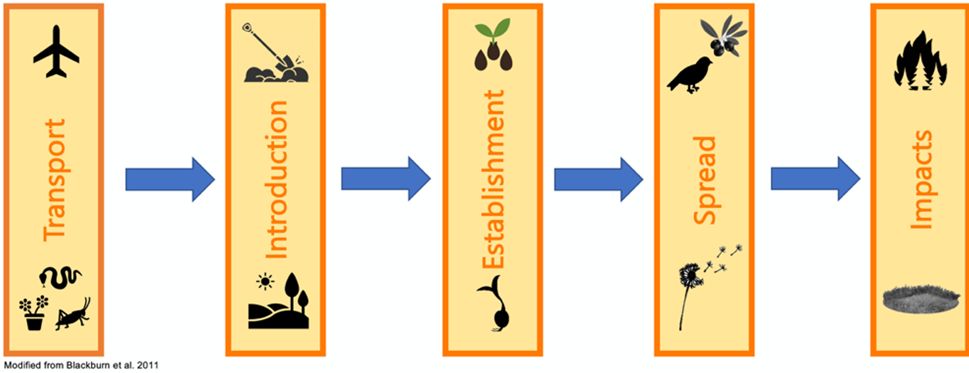
Credit: Deah Lieurance, UF/IFAS
1) Transport
The first stage of a biological invasion requires a species to be transported beyond the boundaries of its native range. As the world becomes more interconnected through globalization, the volume and frequency of species moving beyond natural dispersal distances is increasing (Meyerson and Mooney 2007). This step is possibly the most intuitive in the invasion process; it is simply the method by which a species is transported to a new location. A good example is the transport of freight and commodities that are regularly shipped across seas and oceans in shipping containers (Figure 3). Ships transport more than 80% of world trade by volume (United Nations Conference on Trade and Development 2021), and Florida’s 15 public seaports received about 38.7 million tons of international imports in 2018 (FDOT 2019). Similarly, air cargo plays a critical role in the global movement of perishables and freight. Florida received approximately 2.7 million tons of air cargo in 2014 (FDOT 2016). Imports are vital to Florida’s economy and can include nonnative species as the cargo (e.g., pets, ornamental plants) or as hitchhikers within the cargo or on/in the vessel (e.g., woodboring beetles in wooden pallets, organisms in ship ballast water). For example, invasive Burmese pythons and boa constrictors were transported to Florida for the pet trade (Snow et al. 2007), and it is thought that Asian green mussel arrived in Tampa Bay in ballast water or attached to the outside of ships (McGuire and Stevely 2018). State and federal agencies can create guidance and regulations to reduce invasive species transport. For instance, the U.S. Coast Guard now requires ships to manage ballast water to reduce the transport of potentially harmful species (Rosenau et al. 2021).
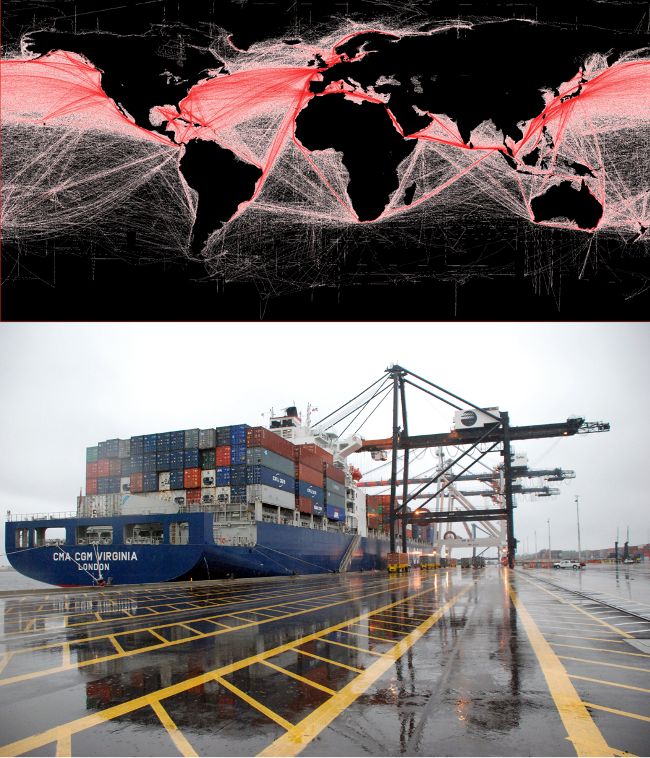
Credit: Top—B. S. Halpern (T. Hengl; D. Groll)/Wikimedia Commons, CC BY-SA 3.0, https://commons.wikimedia.org/w/index.php?curid=18755723. Bottom—JAXPORT from Jacksonville, USA - CMA CGM Virginia, uploaded by Navigans, CC BY 2.0, .
2) Introduction
Once a species has been transported to a new geographic area, the next stage is its introduction to potentially suitable habitat in the wild. These introductions can be accidental or intentional and include: (1) release in nature; (2) release from confinement; (3) escape from confinement; (4) contaminant; and (5) stowaway (Table 1; adapted from Harrower et al. 2018).
Intentional Introductions
Intentional introductions are the result of deliberate human actions that place a species in or near a natural environment (Harrower et al. 2018). Release in nature and release from confinement are the primary pathways for intentional introductions. Release in nature occurs when nonnative species are let go directly in natural environments with the intention to establish breeding populations of those species. Examples include plant introductions for erosion control, dune stabilization, or wind breaks, releasing game for hunting, and stocking lakes for fishing (Table 1). Release from confinement includes intentional releases of previously confined organisms into natural environments as a means of disposal of unwanted plants or animals. Examples include pet releases, live bait releases, and discarded plants into aquatic or terrestrial areas.
Accidental Introductions
Accidental introductions occur when nonnative species are released unintentionally into suitable habitats in the wild because of another human activity. Pathways for these introductions include escape from confinement, commodity contaminant, and transport stowaway. This includes escape from agriculture, aquaculture, botanical gardens, or horticulture, and pet or live bait escapes (Table 1). Contaminants and stowaways are nonnative species that are introduced into the wild through the movement of a commodity (e.g., contaminated nursery material, seed, plants, or timber) or as stowaways on vehicles, boats, or airplanes transporting goods (e.g., ballast water, ship hull fouling, wood packing material).
Table 1. Introduction pathways and examples from Florida for intentional and accidental release of nonnative species (Harrower et al. 2018).
3) Establishment
Establishment of a nonnative species happens when repeated reproduction and survival of individuals result in a population capable of maintaining itself in the wild (Blackburn et al. 2011). Survival and reproduction rely on many abiotic (nonliving) and biotic (living) factors. Florida’s diverse habitats create a range of abiotic and biotic conditions that can promote or hinder invasive species establishment. Brazilian peppertree (Schinus terebinthifolius) is established in south and central Florida but cannot survive in most of northern Florida because winter temperatures are too cold (abiotic constraint) (Osland and Feher 2020). Skunk vine (Paederia foetida) reproduction depends on pollinators, which vary in effectiveness and abundance across Florida habitats (biotic constraint) (Liu et al. 2006). Establishment also relies on characteristics of the introduced nonnative species. For example, generalists can feed on a variety of sources or flourish in a wide range of habitats, while specialists are often limited by access to resources and inhabit a much narrower niche. For instance, cogongrass (Imperata cylindrica) changes its growth form to access light in shady environments while co-occurring native species do not (Hiatt and Flory 2020). The Argentine black and white tegu (Salvator merianae) is a large lizard that originally established in southern Florida. Subsequent introductions have also resulted in established populations in Georgia (Haro et al. 2020). This species is projected to spread to other areas in the southeastern United States based on its ability to hibernate and tolerate cold temperatures (Jarnevich et al. 2018; Goetz et al. 2021).
4) Spread
The spread of a nonnative species can be described as an expansion phase where the range or area the species occupies increases. Spread is dependent on a species’ reproductive success, localized dispersal of offspring or propagules, and long-distance dispersal aided by humans. Species with high reproductive rates, such as insects that reproduce multiple times in a year or a plant that produces tens of thousands of seeds that are easily dispersed, have an advantage, especially if there is also high offspring survival. Additionally, species with efficient natural dispersal mechanisms (e.g., the production of fruits eaten and later deposited by birds, the ability to swim) can spread further. For example, Rhesus macaques (Macaca mulatta) spread from their initial point of introduction on an island in the Silver River by swimming to the forest (Anderson et al. 2022). Finally, species that are moved intentionally or accidentally by humans can make long-distance jumps. For instance, recreational boating and the use of bait buckets can spread aquatic invasive species to new waterbodies if vessels are not carefully checked (Vander Zanden and Olden 2008). Peter’s rock agama and other invasive lizards can move long distances by hitchhiking on cars and in freight distributed by train (Figure 4) (Gioeli and Johnson 2020; Gray 2020; Moore 2019).
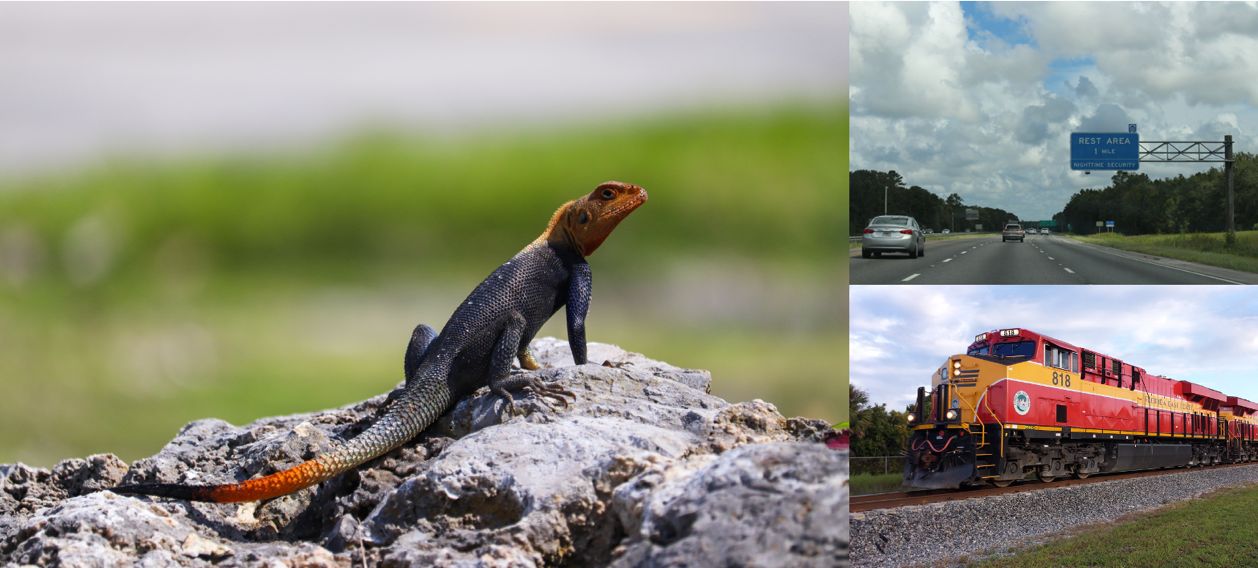
Credit: Left—Peter Xiong, UF/IFAS. Top right—Michael Rivera - Own work, CC BY-SA 4.0, https://commons.wikimedia.org/w/index.php?curid=72493776. Bottom right—BBT609 - Own work, CC BY-SA 4.0, https://commons.wikimedia.org/w/index.php?curid=46628327.
5) Impacts
The final stage of invasion involves the nonnative species causing negative impacts to the environment (ecological), economy, or human health (Figure 5). Any significant change in an ecological pattern or process caused by a nonnative species is a negative ecological impact (Simberloff et al. 2013). This impact could involve alterations of fire regimes, changes in watershed hydrology and nutrient cycling, reductions in biodiversity, or increased soil erosion. Economic impacts can include costs to control invasive species, lost yield of agricultural crops, and/or lost revenue in recreational activities. Finally, impacts to human health can be as simple as causing mild allergies and rashes, to spreading life-threatening diseases and even potentially deadly attacks.

Credit: Left—Tony Pernas, USDI National Park Service, Bugwood.org; Center—Deah Lieurance, UF/IFAS; Right—Susan Ellis, Bugwood.org
Ecological
The ecological impacts of invasive species can affect the native community and the ecosystem itself, ultimately resulting in degraded habitat and reduced biodiversity. Melaleuca (Melaleuca quinquenervia) invasion in the Everglades is a great example of negative ecological impacts to an ecosystem. These trees have high concentrations of flammable volatile oils that promote intense canopy fires, killing native plants and triggering the release of millions of melaleuca seeds that can recolonize the area after the fire (Serbesoff-King 2003). The subsequent formation of dense stands of melaleuca in Florida and the Caribbean Islands has displaced native vegetation in sensitive wetland habitats (Rayamajhi et al. 2009). Feral hogs (Sus scrofa) are an invasive species that are rapidly increasing in numbers and range size across North America. They are generalists that feed on both plants and animals. Their behavior—feeding, rooting in the soil for food, wallowing in water or mud to stay cool—alters the ecosystem by degrading the natural habitat and lowering biodiversity (Singer et al. 1984). One study determined that mammal and bird diversity declined 26% where feral hogs were present (Ivey et al. 2019). Feral hogs are also known to carry diseases, including foot and mouth disease, which can have serious impacts on native mammals and domesticated livestock (Morgan et al. 2021).
Economic
One of the most devastating examples of negative economic impacts of invasive species in Florida is the impact of citrus greening (Citrus huanglongbing). Citrus greening is a bacterial infection spread by the Asian citrus psyllid (Diaphorina citri) that limits nutrient uptake and reduces fruit yield, size, and quality, ultimately increasing tree mortality (Singerman and Useche 2019). Citrus greening has resulted in a significant reduction in acreage and yield. As of 2016, approximately 80% of citrus in Florida was infected (Singerman and Useche 2019). It is estimated that citrus greening has cost Florida farmers billions in lost revenue (Alvarez et al. 2016).
Human Health
Nonnative Asian tiger mosquitoes (Aedes albopictus) and yellow fever mosquitoes (A. aegypti) are aggressive biters and can spread viruses, including West Nile, Zika, Chikungunya, and dengue (Lounibos et al. 2016; Rios and Maruniak 2018). Zika made headlines in 2016 when the first locally transmitted cases were reported in central and south Florida, the first in the continental United States (Lounibos et al. 2016). Zika is passed from vector to host through the bite, and symptoms include fever, rash, joint pain, pink eye, and potentially congenital microcephaly in newborn babies (Lounibos et al. 2016).
What can you do to stop the spread?
Thinking about the volume and distribution of invaders and their impacts in Florida can be overwhelming, but there are simple actions you can take to help stop the spread of invasive species. The best way to fight invasions is to prevent the introduction of potential invaders and keep invaders already in the state from spreading. You can do this by: (1) making well-informed choices when selecting plants or pets; (2) cleaning your boots and boats before moving to a new recreation area; (3) making sure you “don’t pack a pest” when traveling; and (4) disposing of garden waste responsibly, and making sure you do not release bait, aquarium fish, or “exotic” pets into the wild.
1) Make well-informed choices
The UF/IFAS Assessment of Nonnative Plants in Florida's Natural Areas uses literature-based invasion risk assessment and decision support tools to assess nonnative species that occur in the state as well as species proposed for introduction (Figure 6). The UF/IFAS recommendations and supporting information for more than 900 species from the UF/IFAS Assessment can be found at http://assessment.ifas.ufl.edu. Homeowners and others can use these recommendations to make responsible decisions when selecting plants and to identify invasive plants to remove and replace in their yards. If you are interested in owning a nonnative pet, research and plan ahead to make sure you can commit to looking after it. For example, some “tank-buster” species start out small but grow to large sizes. Others live for a very long time. Check the Florida Fish and Wildlife Conservation Commission (FFWCC) Nonnative Fish and Wildlife Program’s Prohibited Nonnative Species list before purchasing “exotic” pets (https://myfwc.com/wildlifehabitats/nonnatives/prohibited-species-list/).
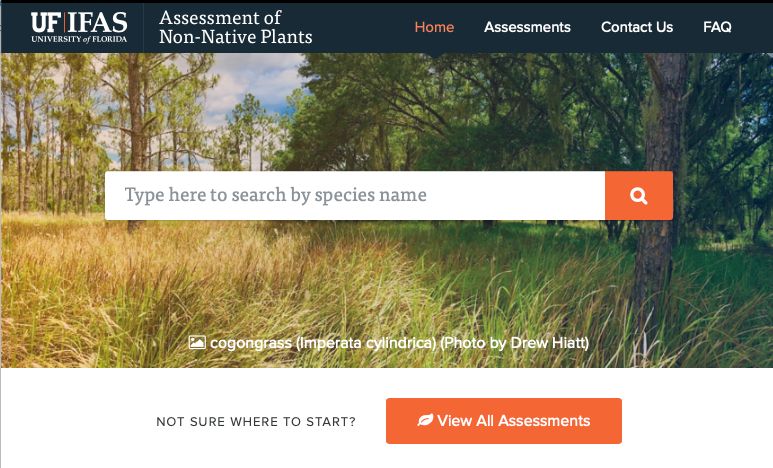
Credit: Deah Lieurance, UF/IFAS
2) Clean your equipment
Programs such as Play Clean Go® powered by NAISMA (https://playcleango.org) prevent invasive species from being introduced or spread during recreation activities (Figure 7). Before traveling to new areas, inspect and clean your trailers, off-road vehicles, and recreational vehicles, and clean your horse’s hooves. Cleaning hiking boots, clothing, and gear before you enter or leave an area and using boot brush stations where available can help remove seeds and pathogens from entering Florida’s natural areas.
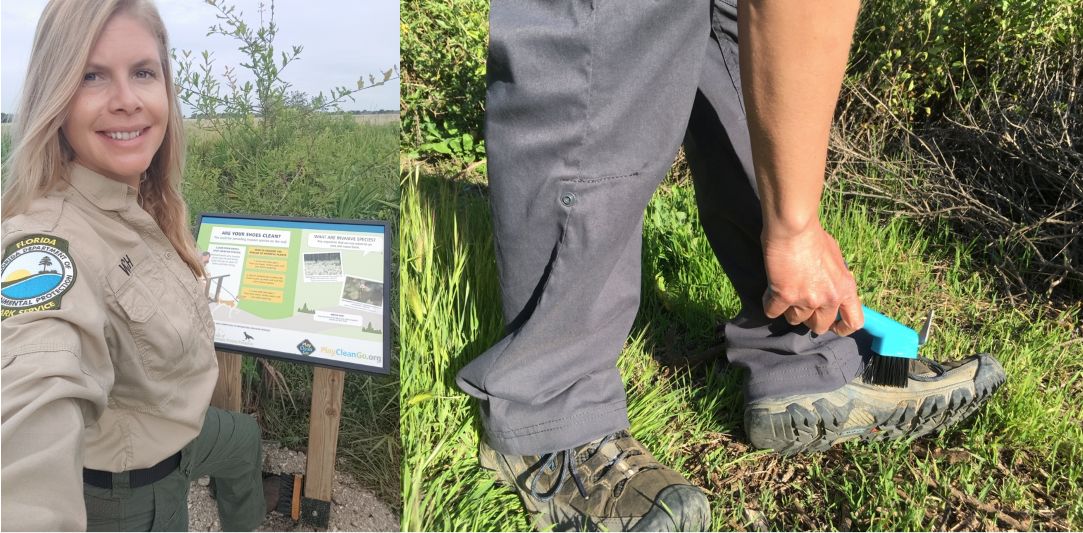
Credit: Left—Catherine Welch, Kissimmee Prairie Preserve State Park. Right—Heather Schneider, Santa Barbara Botanic Garden. Both photos courtesy of the North American Invasive Species Management Association, PlayCleanGo®.
3) Don’t pack a pest
When traveling, take care to avoid moving around plants, fruits, vegetables, firewood, and other items that might carry invasive species or pathogens, or that might become invaders themselves. You can check https://www.dontpackapest.com before traveling internationally to find out what can and cannot be brought into the United States. When camping, purchase firewood where you burn it, look for certified heat-treated firewood, or gather on-site (when permitted).
4) Do not release nonnative species in natural areas
This applies to all types of nonnative species. Strive to prevent accidental introductions by disposing of garden waste responsibly (e.g., double-bag noxious weeds for disposal, do not toss unwanted plants over the fence). Similarly, do not dump unwanted aquarium fish or plants into canals and natural waterways. Finally, do not release unwanted pets in the wild. FFWCC offers many Exotic Pet Amnesty where owners may surrender nonnative pets for any reason at no cost or penalty, regardless of regulatory status (https://myfwc.com/wildlifehabitats/nonnatives/amnesty-program/). These pets are often rehomed to approved adopters. Additionally, if you see invasive wildlife, call the FFWCC’s Exotic Species Hotline at 888-IVE-GOT1 (483-4681) or report it on the app (Figure 8).
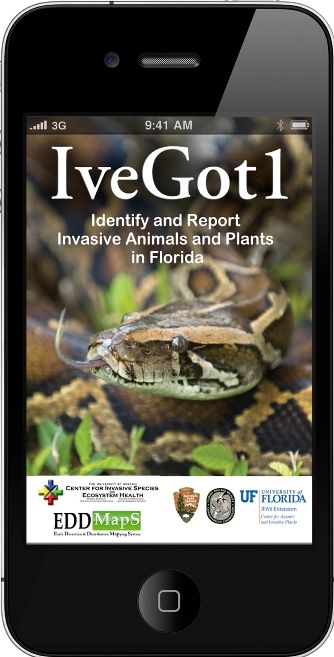
Credit: Chuck Bargeron, Bugwood.org
Conclusion
Understanding the stages of invasion in combination with the species traits and environmental conditions that allow a species to complete the invasion process is critical to invasive species prevention and eradication efforts. This information can be synthesized using risk assessment and other invasive species screening tools to determine if a nonnative species has a high probability or risk of becoming an invasive species. These tools are often structured to follow the stages of invasion and are ideally used to identify invaders before they are introduced (Roy et al. 2017). Screening tools can also identify invaders when they are in the establishment and spread phases, allowing managers to prioritize management and eradicate populations before they cause negative impacts. Similarly, identifying nonnative species that can establish but not spread could provide prospects for new crops, horticulture selections, and animals for agriculture and aquaculture purposes. Understanding the strengths and vulnerabilities of a nonnative species as they relate to these stages is necessary to making informed decisions about prohibiting entry, recommending for use, or targeting for eradication.
References
Alvarez, S., E. Rohrig, D. Solís, and M. H. Thomas. 2016. “Citrus Greening Disease (Huanglongbing) in Florida: Economic Impact, Management and the Potential for Biological Control.” Agricultural Research 5:109–118. https://doi.org/10.1007/s40003-016-0204-z
Anderson, C. J., A. C. Wilson, M. E. Hostetler, and S. A. Johnson. 2022. "Introduced Monkey Populations of Florida—History, Status, and Potential Impacts: WEC446/UW491, 2/2022." EDIS 2022(1). https://doi.org/10.32473/edis-UW491-2022
Blackburn, T. M., P. Pyšek, S. Bacher, J. T. Carlton, R. P. Duncan, V. Jarošík, J. R. U. Wilson, and D. M. Richardson. 2011. “A Proposed Unified Framework for Biological Invasions.” Trends in Ecology & Evolution 26:333–339. https://doi.org/10.1016/j.tree.2011.03.023
Florida Department of Transportation. 2016. “Florida Air Cargo Study.” Accessed September 30, 2021. https://www.fdot.gov/aviation/cargo.shtm
Florida Department of Transportation. 2019. “Florida Seaport Plan: 2018 Update of Tables and Figures.” Accessed September 30, 2021. https://fdotwww.blob.core.windows.net/sitefinity/docs/default-source/seaport/pdfs/2018-update-of-tables-and-figures-florida-seaport-system-plan-717752830.pdf?sfvrsn=e1879b60_2
Florida Department of Transportation. 2021. “Continuing Florida’s Aviation System Planning Process.” Accessed September 30, 2021. https://www.cfaspp.com/Airport/AirportList.aspx
Florida Ports Council. 2021. “The Florida System of Seaports.” Accessed September 30, 2021. https://flaports.org/about/the-florida-system-of-seaports/
Gioeli, K., and S. A. Johnson. 2020. “Peters's Rock Agama in Florida: WEC431/UW476, 9/2020.” EDIS 2020(5): 5. https://doi.org/10.32473/edis-uw476-2020
Goetz, S. M., D. A. Steen, M. A. Miller, C. Guyer, J. Kottwitz, J. F. Roberts, E. Blankenship, P. R. Pearson, D. A. Warner, and R. N. Reed. 2021. "Argentine black and white tegu (Salvator merianae) can survive the winter under semi-natural conditions well beyond their current invasive range." PLOS One 16:e0245877. https://doi.org/10.1371/journal.pone.0245877
Gray, R. J. 2020. "Exotic Hobos: Release, Escape, and Potential Secondary Dispersal of African Red-Headed Agamas (Agama picticauda PETERS, 1877) through the Florida Railway Systems." BioRxiv. https://doi.org/10.1101/2020.05.11.089649
Haro, D., L. D. McBrayer, J. B. Jensen, J. M. Gillis, L. Bonewell, M. G. Nafus, S. E. Greiman, R. N. Reed, and A. A. Yackel Adams. 2020. "Evidence for an Established Population of Tegu Lizards (Salvator merianae) in Southeastern Georgia, USA." Southeastern Naturalist 19:649–662. https://doi.org/10.1656/058.019.0404
Harrower, C. A., R. Scalera, S. Pagad, K. Schonrogge, and H. E. Roy. 2018. “Guidance for Interpretation of CBD Categories on Introduction Pathways.” Technical note prepared by IUCN for the European Commission. http://nora.nerc.ac.uk/id/eprint/519129/1/N519129CR.pdf
Hiatt, D., and S. L. Flory. 2020. “Populations of a widespread invader and co‐occurring native species vary in phenotypic plasticity.” New Phytologist 225:584–594. https://doi.org/10.1111/nph.16225
Hiatt, D., K. Serbesoff‐King, D. Lieurance, D. R. Gordon, and S. L. Flory. 2019. "Allocation of Invasive Plant Management Expenditures for Conservation: Lessons from Florida, USA." Conservation Science and Practice 1:e51. https://doi.org/10.1111/csp2.51
Ivey, M. R., M. Colvin, B. K. Strickland, and M. A. Lashley. 2019. “Reduced Vertebrate Diversity Independent of Spatial Scale Following Feral Swine Invasions.” Ecology and Evolution 9(13): 7761–7767. https://doi.org/10.1002/ece3.5360
Jarnevich, C. S., M. A. Hayes, L. A. Fitzgerald, A. A. Y. Adams, B. G. Falk, M. A. Collier, L. R. Bonewell, P. E. Klug, S. Naretto, and R. N. Reed. 2018. “Modeling the Distributions of Tegu Lizards in Native and Potential Invasive Ranges.” Scientific Reports 8:1–12. https://doi.org/10.1038/s41598-018-28468-w
Liu, H., R. W. Pemberton, and P. Stiling. 2006. “Native and introduced pollinators promote a self‐incompatible invasive woody vine (Paederia foetida L.) in Florida.” The Journal of the Torrey Botanical Society 133:304–311. https://www.jstor.org/stable/20063841
Lounibos, P., B. W. Alto, N. Burkett-Cadena, C. C. Lord, C. T. Smartt, C. R. R. Connelly, and J. R. Rey. 2020. “Zika, a Mosquito-Transmitted Virus.” ENY-888. Gainesville: University of Florida Institute of Food and Agricultural Sciences. https://edis.ifas.ufl.edu/in1120
McGuire, M., and J. Stevely. 2009. "Invasive Species of Florida's Coastal Waters: The Asian Green Mussel (Perna viridis)." SGEF 175. Gainesville: University of Florida Institute of Food and Agricultural Sciences. https://edis.ifas.ufl.edu/sg094
Meyerson, L. A., and H. A. Mooney. 2007. “Invasive Alien Species in an Era of Globalization.” Frontiers in Ecology and the Environment 5:199–208. https://doi.org/10.1890/1540-9295(2007)5[199:IASIAE]2.0.CO;2
Moore, J. A. 2019. "Agama picticauda (Peter's Rock Agama) Dispersal." Herpetological Review 50: 360.
Morgan, J. T., J. Fischer, and M. E. Hostetler. 2003. “If Foot-and-Mouth Disease Came to Florida: Potential Impact on White-Tailed Deer in Florida.” WEC 171. Gainesville: University of Florida Institute of Food and Agricultural Sciences. https://edis.ifas.ufl.edu/uw183
Osland, M. J., and L. C. Feher. 2020. “Winter Climate Change and the Poleward Range Expansion of a Tropical Invasive Tree (Brazilian Pepper—Schinus terebinthifolius).” Global Change Biology 26:607–615. https://doi.org/10.1111/gcb.14842
Rayamajhi, M. B., P. D. Pratt, T. D. Center, P. W. Tipping, and T. K. Van. 2009. “Decline in exotic tree density facilitates increased plant diversity: The Experience from Melaleuca quinquenervia Invaded Wetlands.” Wetlands Ecology and Management 17:455–467. https://doi.org/10.1007/s11273-008-9123-5
Rios, L., and J. E. Maruniak. 2018. “Featured Creatures—Asian Tiger Mosquito.” Gainesville: University of Florida Institute of Food and Agricultural Sciences. https://entnemdept.ufl.edu/creatures/aquatic/asian_tiger.htm
Rocus, D., and F. J. Mazzotti. 1996. “Threats to Florida's Biodiversity.” SSWEC70. Gainesville: University of Florida Institute of Food and Agricultural Sciences.
Rosenau, N. A., S. Gignoux-Wolfsohn, R. A. Everett, A. W. Miller, M. S. Minton, and G. M. Ruiz. 2021. “Considering Commercial Vessels as Potential Vectors of Stony Coral Tissue Loss Disease.” Frontiers in Marine Science 8:1302. https://doi.org/10.3389/fmars.2021.709764
Roy, H. E., W. Rabitsch, R. Scalera, A. Stewart, B. Gallardo, P. Genovesi, F. Essl, T. Adriaens, S. Bacher, O. Booy, and E. Branquart. 2018. “Developing a Framework of Minimum Standards for the Risk Assessment of Alien Species.” Journal of Applied Ecology 55:526–538. https://doi.org/10.1111/1365-2664.13025
Schmitz, D. C. (ed.) 2002. “Statewide Invasive Species Strategic Plan for Florida 2002.” South Florida Ecosystem Restoration Task Force. http://www.sfrestore.org/ies/meetings/091713/Statewide_Invasive_Species_Strategic_Plan_for_Florida_2002.pdf
Secretariat of the Convention on Biological Diversity. 2001. “Assessment and Management of Alien Species That Threaten Ecosystems, Habitats and Species.” Abstracts of Keynote Addresses and Posters Presented at the Sixth Meeting of the Subsidiary Body on Scientific, Technical and Technological Advice, held in Montreal, Canada, March 12–16, 2001. Montreal, SCBD. CBD Technical Paper no. 1.
Serbesoff-King, K. 2003. “Melaleuca in Florida: A Literature Review on the Taxonomy, Distribution, Biology, Ecology, Economic Importance and Control Measures.” Journal of Aquatic Plant Management 41:98–112.
Simberloff, D., J. L. Martin, P. Genovesi, V. Maris, D. A. Wardle, J. Aronson, et al. 2013. “Impacts of Biological Invasions: What's What and the Way Forward.” Trends in Ecology & Evolution 28:58–66. https://doi.org/10.1016/j.tree.2012.07.013
Singer, F. J., W. T. Swank, and E. E. C. Clebsch. 1984. “Effects of Wild Pig Rooting in a Deciduous Forest.” The Journal of Wildlife Management 48:464–473. https://www.jstor.org/stable/3801179
Singerman, A., and M. P. Useche. 2019. “Impact of Citrus Greening on Citrus Operations in Florida.” FE983. Gainesville: University of Florida Institute of Food and Agricultural Sciences. https://edis.ifas.ufl.edu/fe983
Snow, R. W., K. L. Krysko, K. M. Enge, L. Oberhofer, A. Warren-Bradley, and L. Wilkins. 2007. “Introduced Populations of Boa constrictor (Boidae) and Python molurus bivittatus (Pythonidae) in Southern Florida.” In Biology of Boas and Pythons, edited by R. W. Henderson and R. Powell. 365–386. Eagle Mountain, UT: Eagle Mountain Publishing.
United Nations Conference on Trade and Development. 2021. “Review of Maritime Transport 2021.” United Nations Publications. #YNCTAD/RMT/2021. https://unctad.org/system/files/official-document/rmt2021_en_0.pdf
United States Census Bureau. 2021. “Foreign Trade Import Data.” Accessed September 30, 2021. https://www.census.gov/foreign-trade/statistics/state/destination_state/exh2as_1912.pdf
U.S. Executive Order No. 13112, 64 Fed. Reg. 6183. February 3, 1999.
Vander Zanden, M. J., and J. D Olden. 2008. “A Management Framework for Preventing the Secondary Spread of Aquatic Invasive Species.” Canadian Journal of Fisheries and Aquatic Sciences 65:1512–1522. https://doi.org/10.1139/F08-099
VISIT FLORIDA Research. 2021. “Florida Visitor Estimates.” Accessed October 3, 2021. https://www.visitflorida.org/resources/research/
Volk, M. I., T. S. Hoctor, B. B. Nettles, R. Hilsenbeck, F. E. Putz, and J. Oetting. 2017. “Florida Land Use and Land Cover Change in the Past 100 Years.” In Florida's Climate: Changes, Variations, & Impacts. 51–82. Florida Climate Institute.
Williamson, M., and A. Fitter. 1996. "The Varying Success of Invaders." Ecology 77:1661–1666. https://doi.org/10.2307/2265769